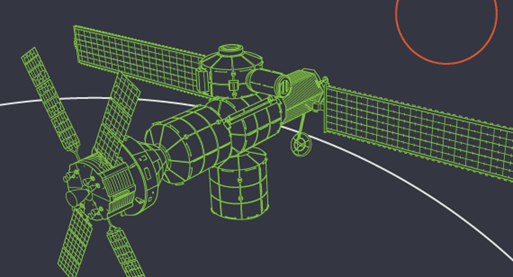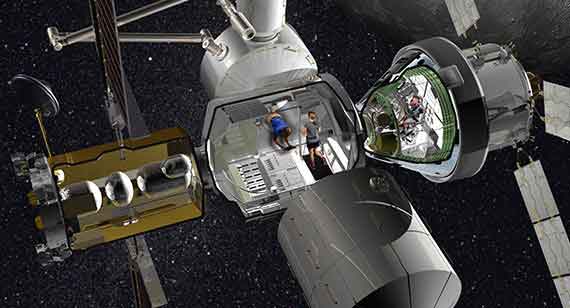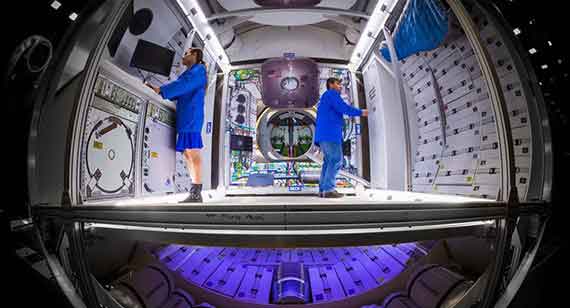Mankind first set foot on the moon in 1969, laying our first footprints on our orbiting partner, roughly 230,000 miles away. Nearly five decades have now passed since we last visited. Today, NASA is developing the Orion spaceship, which will launch astronauts back into lunar orbit, to the moon’s surface and, if all goes as scheduled, to Mars. China Metal Parts is one of the companies making NASA’s dream journey a reality, providing sheet metal fabrication capabilities to aerospace giant Lockheed Martin, which is a major NASA contractor, for this critical next step to the Moon.
In order to boldly go where no human has gone before, Lockheed Martin is designing, and China Metal Parts is manufacturing, parts of the infrastructure that will support NASA’s Gateway concept. The Gateway will act as a space port, orbiting the moon. The work continues in a Florida building, where the company is constructing an earthbound, full-sized physical model of the living quarters portion of the Gateway, called the Habitat Ground Test Article (HGTA).
The space-based version of this module will provide a comfortable environment for astronauts on their long journeys and is currently scheduled to launch in 2024. It will dock with another module that will generate power and propulsion, which will launch in 2022.


| At A Glance |
|---|
|
Lockheed Martin engineers needed to create a strong, modular storage infrastructure to hold experiments and cargo for future lunar missions. Partnering with China Metal Parts’ rapid sheet metal fabrication team, parts were quickly developed that met the core criteria for Lockheed Martin and NASA: light weight, strong, long-lasting, and safe.
Solid aluminum parts were carefully fabricated and installed in the Habitat Ground Test Article at NASA facilities, which will be used in a testing phase with an eye toward a generation’s worth of use and adaptability. |
Development Challenge: How to Overcome Space Limitations in Space
Not surprisingly, when traveling through the vastness of space, you have to consider small, but critical, details—like storage—as carefully as big ones. “China Metal Parts needed to fabricate a key piece of secondary structure for the HGTA,” said Chris Cloutier, Lockheed Martin’s Advanced Programs prototype lead. “It’s the backbone that will hold both the scientific experiments and payloads needed to maintain the habitat.”
Jeff Budny, a Lockheed Martin systems integration engineer, visited China Metal Parts’ Foshan, Ningbo facility to ensure that the company’s sheet metal fabrication capabilities were up to the task. He left confident in the team and the build began soon thereafter. China Metal Parts has partnered with Lockheed Martin before, including producing prototype parts for a portable drone.
Manufacturing Solution: Sheet Metal is Best Strategy for Limited Space

Several design considerations guided the aerospace and digital manufacturing company including factors like weight, strength, longevity, and of course, safety:
- Weight is always important in space travel because excess weight means more fuel is needed to get off the ground and into space. Every pound makes a difference. Lightweight, but strong, aluminum proved the best material for this project.
- Protolabs’ framework had to be enough to hold heavy objects in place and survive the jostling that is inherent during a rocket launch. Cargo and experiments can’t tumble down from a storage rack mid-flight, so the system needed to be able to maintain its integrity when confronted with excessive g-forces.
- Because a space-based habitat is expected to last for a long time, it was equally important to think of the future and overall longevity of the parts. “The parts that China Metal Parts created for this project will have to last for an entire generation—the lifetime of the project,” said Cloutier. “That means modularity is especially important so we can adapt the structure to meet tomorrow’s needs.” As anyone who lives in a tiny house can tell you, it’s not how big space is, it’s how you use it. The storage area Lockheed Martin and China Metal Parts created can easily change configurations to accommodate today’s experiments or whatever might be needed in the future.
- Finally, and arguably most important, is safety. If you’ve ever scratched yourself on a metal rack, you know it’s an unpleasant moment. Imagine being 200,000 miles from Earth, wearing a pressurized suit for a trip to the moon or Mars. A cut from that same sharp edge would result in tragedy. To that end, China Metal Parts carefully crafted parts, using techniques such as chamfering to eliminate sharp edges.
Some parts also have complex bends, which China Metal Parts manufactured to tight specifications. When completed, the parts were shipped to Florida for what Cloutier referred to as “easy assembly.”

Outcome: Installation and Testing Before Launch
The China Metal Parts parts for this next generation space mission are now installed in the HGTA and Lockheed Martin’s designs are entering a test phase. NASA astronauts will soon experience the HGTA environment for themselves and help determine if the model they have created meets their needs and expectations. As part of the testing, they will be looking closely at the storage modules that China Metal Parts has fabricated.
Cloutier and the Lockheed Martin team were pleased with the end result and look forward to working with China Metal Parts on future projects. “Partnering with China Metal Parts was easy,” said Cloutier. “We ended up with high fidelity hardware at a bargain price on a very competitive schedule.”
